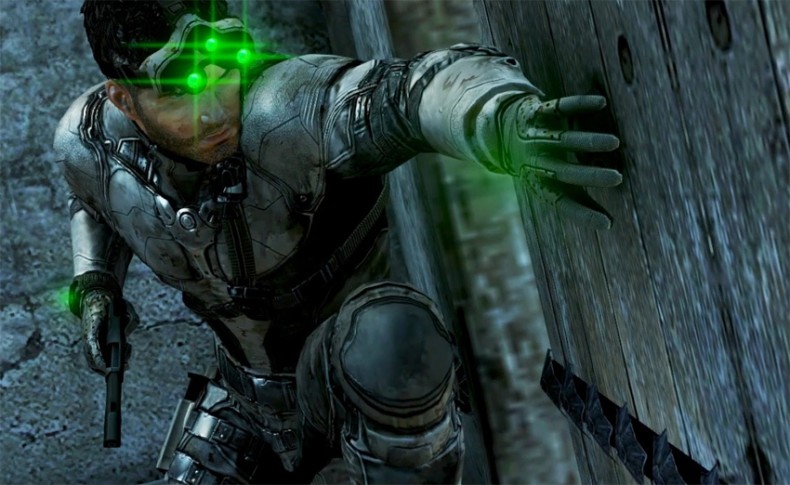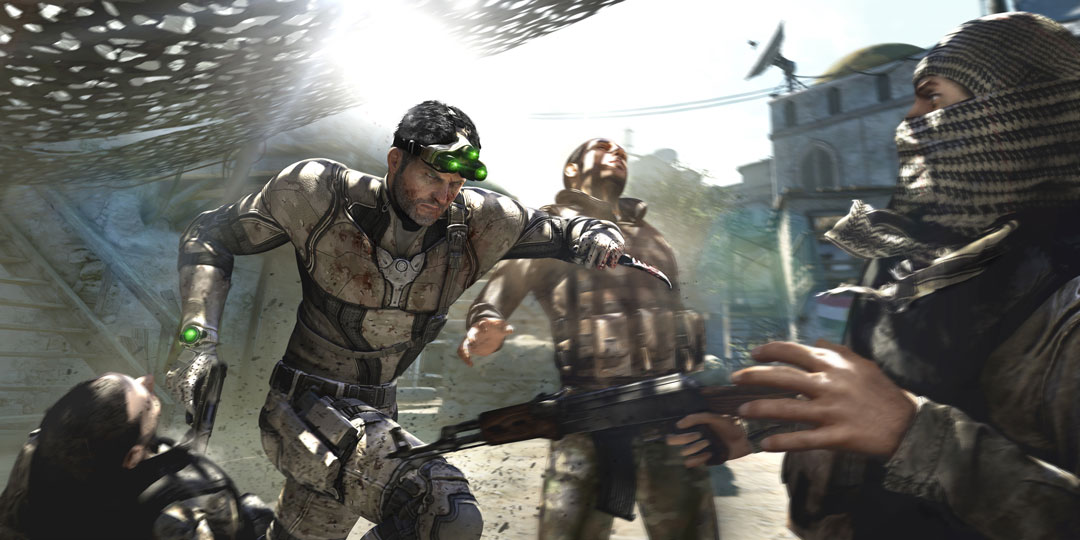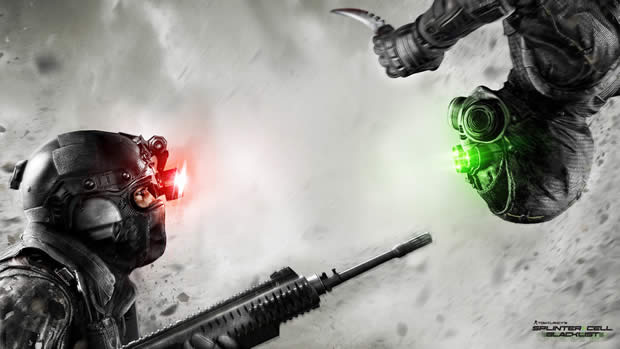Splinter Cell: Blacklist Mega-Review

Fluid and engaging gameplay, packed with loads of content, Spies vs Mercs is back and better than ever
The load times are long, and the graphics look slightly dated
Splinter Cell: Blacklist is hands-down my favorite Splinter Cell game of all time. It's loaded with content, has an engaging story, and an insanely fun multiplayer that will keep me coming back for more, despite its minor flaws. Go out and buy this game NOW!
You Can’t Stop the Blacklist
It’s very rare that a sequel can live up to its predecessor, and even moreso when the sixth installment makes a run at the best game in the series. Well, I can safely say that Splinter Cell: Blacklist has somehow pulled off the impossible and done just that. Combining the best elements from Conviction (mark-and-execute and the ability to move from cover to cover) with the supremely satisfying stealth of the earlier titles, and with the addition of a few new mechanics of its own, Blacklist has excelled itself to become one of the best, if not the best, Splinter Cell game to date.
Story
The main story of Blacklist is pretty straightforward: a terrorist organization known as the Engineers blows up a U.S. military base and threatens to carry out an attack every week (called the Blacklist) until the U.S. brings home all its troops. While this plot sounds very elementary, I found myself engaged and intrigued by the story as the game progressed, and actually became really immersed in what was going on. I noticed that, as each level unraveled, I adjusted my gameplay to play along with the urgency of the story. For instance, in the slower levels I tended to take my time and slowly ghost my way through, but in levels where the U.S. was in imminent danger, I was inclined to book it through and play more aggressively, all for the sake of the Red, White, and Blue. It was a cool experience to have, and it made me enjoy the game even more than I already did.

Badass doesn’t even begin to describe Sam Fisher
Gameplay
In Splinter Cell: Blacklist, the game is tailored to whatever playstyle you choose. If you want to go in loud and make your presence known to the guards, you can. If you want to sneak through and stealthily kill everyone – have at it. Hell, you can even go through the entire game without killing anyone!. The choice is all yours. Whichever approach you end up using, it will fall into one of 3 categories: Ghost (non-lethal and stealthy), Panther (lethal and stealthy), and Assault (loud and lethal). At the end of each mission, your performance will be assessed in each category and you’ll receive rewards according to how you did. The points then translate to in-game cash (through some unknown algorithm) that you can use to buy new weapons, weapon attachments/aesthetics, gadgets, upgrades for the Paladin (mobile air-base), and ops suits to make you even more badass.
One great addition to Blacklist is the ability to customize a loadout before you start a mission. Unlike in the previous games, which gave you no choice and customization for what you brought into a mission, Blacklist allows you to adjust your loadout to however you like playing the game. If you’re more of an assault player, bring loud rifles and frags. If you’re more of a panther or ghost player, bring silenced weapons and gadgets that draw enemies’ attention. It’s all customizable to fit your needs and to make you the world’s most deadly agent.
Once you’re finally in the game proper, the gameplay is both familiar and different to fans of the series. I had played Splinter Cell: Conviction in its entirety a couple days before Blacklist was released, and one of the first things that I noticed was the difference in the controls. While I found Conviction’s controls to be more clunky and poorly assigned, I was beyond happy to see that Ubisoft Toronto had picked a more logical button layout this time around (although it took me a level or two before I shook off the Conviction controls). This made playing feel a lot smoother, which in Blacklist, is the name of the game.
 What do I mean by smoothness is the “name of the game� Well, one of the biggest improvements I notice and praise is how smooth and fluid the gameplay is. Sam moves seamlessly from cover, climbs walls automatically when you sprint up to them, and can knife an enemy in the face without breaking stride. Its almost elegant how beautifully smooth every action you make is. This makes it much more believable that you are actually a bad ass killer, and not some clumsy, lumbering buffoon with a pistol.
What do I mean by smoothness is the “name of the game� Well, one of the biggest improvements I notice and praise is how smooth and fluid the gameplay is. Sam moves seamlessly from cover, climbs walls automatically when you sprint up to them, and can knife an enemy in the face without breaking stride. Its almost elegant how beautifully smooth every action you make is. This makes it much more believable that you are actually a bad ass killer, and not some clumsy, lumbering buffoon with a pistol.
The main premise of Splinter Cell still rings true in Blacklist: you still try to stick to the shadows, climb pipes, scale buildings, get the drop on enemies, and hide bodies to avoid detection. The game is definitely a return to the series’ roots after the more action-based turn that Conviction took, and it’s a welcome return for fans of the series (like Yours Truly). That isn’t to say that Blacklist is exactly like the old games, however. It still totes a bunch of new features and additions that give this game its own personality.
One of the biggest new features is the Paladin, the plane that serves as main headquarters of Fourth Echelon. In the game, it’s the central hub for everything: players start missions, purchase upgrades, and begin multiplayer matches all from this one, centralized location (if you’ve played the Mass Effect series, think of the Paladin as Splinter Cell’s version of the Normandy). While I’m a fan of the simplicity of a main menu, navigating around the Paladin isn’t that cumbersome, and actually verges on being enjoyable.
Graphics and Sound
As I played through Blacklist, I was torn about how the game looked. At some points, everything looked beautiful, like when I was ninja’ing my way through the sun-soaked streets of Benghazi, Lybia. Other times, it looked less than stellar, like when I was sneaking through the dull looking Columbian mansion. The cut-scenes in Blacklist were actually a bit of a letdown as well, since the character models looked a bit dated. However, I was able to look past this because the performances that each character gave drew my attention completely.
The cast of Blacklist is a major strong point for the game. Each actor brought their character to life and made me really believe how stressed out they were with the realization that the fate of the United States rested squarely on their shoulders. The voice actor that played the leader of the Engineers gave an exceptionally good performance, portraying a cold, yet surprisingly calm villain. Hell, even Eric Johnson, who replaced the legendary Michael Ironside as the voice of Sam Fisher, did a solid job filling in Ironside’s shoes. I would also like to make a note that the guards in Blacklist were a LOT less annoying than the guards in Conviction, who were overly cocky and talked way too much. It was nice to fight against an enemy that sounded surprisingly human.
The soundtrack is also top notch, boasting some dramatic scores that peak during frantic and confrontational scenes and gameplay, and stays measured and low-key when sneaking around. The gameplay is also backed up by great sounding effects, such as gunshots, explosions, and ambient noises that added a more realistic feel to every environment I went through.
 
Multiplayer
It is my most distinct pleasure to announce the return of Spies vs. Mercs in Blacklist. The hit multiplayer mode that debuted in Chaos Theory and hasn’t been seen since is back and just as awesome as ever. SvM is an online multiplayer game where teams of 2 or 4 (depending on the game-type) are pitted against each other to either play a regular-style deathmatch, or an objective-based game where Spies try to hack 3 terminals and Mercs try to stop them. What’s so unique about this is that Spies play the game in third-person and are as agile as Sam is in the main game, while Mercs play through in first-person mode, ala Call of Duty. It’s such a fun and interesting experience and I will admit, nothing is more satisfying than pulling of an aerial assassination on a Merc that’s being controlled by someone else in the online world. Spies vs. Mercs is a whole lot of fun and will keep me coming back to play again and again. (I’m actually itching to play it right now as I write this).
Blacklist also features several co-op missions that you and a friend can do (or you can do by yourself, since most maps allow you to play solo). While I didn’t see a huge advantage to having a friend come in for most levels, it was still a lot of fun to swiftly take out guards as a team.
 
Issues
As I mentioned before, the character models in the cut-scenes looked below par, but I was able to look past that. Â What I had a harder time looking past was how long everything took to load. I could hit a load screen, drive to the store, run a bunch of errands, drive home, and be back in time to see the level finally load (ok that might have been a bit of an exaggeration, but you get the idea). Other than that, I have no complaints.
Notable Extras
There are a few things you can collect as you play through Blacklist. There are flash drives hidden throughout the levels, as well as high-value targets for you to capture, and laptops for you to hack. While none of these really change the game at all, you do get in-game cash for finding/capturing/hacking them, so they’re worth keeping an eye out for.
SpawnFirst Recommends…
Splinter Cell: Blacklist is hands-down my favorite Splinter Cell game of all time. It’s loaded with content, has an engaging story, and an insanely fun multiplayer that will keep me coming back for more, despite its minor flaws. Go out and buy this game NOW!






